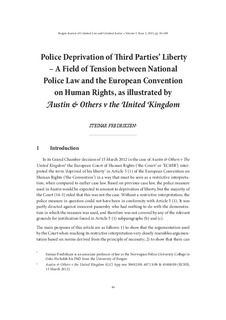| dc.contributor.author | Fredriksen, Steinar | |
| dc.date.accessioned | 2015-08-13T09:30:45Z | |
| dc.date.available | 2015-08-13T09:30:45Z | |
| dc.date.issued | 2015 | |
| dc.identifier.issn | 1894-4183 | |
| dc.identifier.uri | http://hdl.handle.net/11250/296598 | |
| dc.description.abstract | In Austin & Others v the United Kingdom The European Court of Human Rights came to the conclusion that the use of a police cordon, also known as “kettling”, where approximately 2000 people were forced to remain inside the cordon for up to eight hours, did not amount to deprivation of liberty under Article 5 (1) of the European Convention on Human Rights. This conclusion was reached by way of restrictive interpretation of the term “deprivation”. Previous case law establishes a set of criteria to be used when deciding if an infringement on the physical liberty to move from place to place constitutes a deprivation of this liberty, or merely a restriction upon it. These criteria were upheld in Austin, but were found to give room for taking into account the context and circumstances in which the police cordon was used. The previous view of the Court that the grounds justifying deprivations of liberty listed in Article 5 (1) (a-f) are exhaustive, was also upheld.
In this article the starting point is the close relationship between national police law regarding the maintenance of security and public order on one hand, and the principle of necessity on the other. It is emphasised that “necessity”-based norms in national police law can make police measures directed against innocent third parties legal, deprivations of liberty included, but that this possibility would have been absent in Article 5 (1) of the Convention without the aforementioned restrictive interpretation of the term “deprivation”. An attempt is made to show that this interpretation is in fact based on central elements of the principle of necessity. Furthermore, it is attempted to show that the restrictive interpretation can be seen as a reflection of the need acknowledged in national police law, as well as in other articles of the Convention, to direct police measures against innocent third parties. | nb_NO |
| dc.language.iso | eng | nb_NO |
| dc.publisher | Jørn Jacobsen/Annika Suominen | nb_NO |
| dc.subject | police law | nb_NO |
| dc.subject | deprivation of liberty | nb_NO |
| dc.subject | demonstrations | nb_NO |
| dc.subject | principle of necessity | nb_NO |
| dc.subject | disturber principle | nb_NO |
| dc.subject | the European Convention on Human Rights | nb_NO |
| dc.subject | the European Court on Human Rights | nb_NO |
| dc.subject | the Austin judgement | nb_NO |
| dc.subject | politirett | nb_NO |
| dc.subject | frihetsberøvelse | nb_NO |
| dc.subject | demonstrasjoner | nb_NO |
| dc.subject | nødrett | nb_NO |
| dc.subject | nødvendighetsprinsippet | nb_NO |
| dc.subject | forstyrrerprinsippet | nb_NO |
| dc.subject | Den europeiske menneskerettskonvensjon | nb_NO |
| dc.subject | Den europeiske menneskerettsdomstolen | nb_NO |
| dc.subject | Austin-dommen | nb_NO |
| dc.subject | disturber principle | nb_NO |
| dc.title | Police Deprivation of Third Parties’ Liberty: A Field of Tension between National Police Law and the European Convention on Human Rights, as illustrated by Austin & Others v the United Kingdom | nb_NO |
| dc.type | Journal article | nb_NO |
| dc.type | Peer reviewed | nb_NO |
| dc.source.pagenumber | 84-108 | nb_NO |
| dc.source.volume | 3 | nb_NO |
| dc.source.journal | Bergen Journal of Criminal Law and Criminal Justice | nb_NO |
| dc.source.issue | 1 | nb_NO |
| dc.identifier.doi | https://doi.org/10.15845/bjclcj.v3i1.829 | |
| cristin.fulltext | | |
